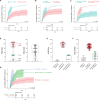Donor HLA-DQ genetic and functional divergence affect the control of BK polyoma virus infection after kidney transplantation
- PMID: 40043107
- PMCID: PMC11881896
- DOI: 10.1126/sciadv.adt3499
Donor HLA-DQ genetic and functional divergence affect the control of BK polyoma virus infection after kidney transplantation
Abstract
BK polyomavirus (BKPyV) infection remains a major concern after kidney transplantation, increasing the risk of graft loss in the absence of specific antiviral agent now available. Here, we investigated the impact of HLA diversity on the control of posttransplant BKPyV replication. High HLA evolutionary divergence (HED) at the DQ locus in the donor was an independent predictor of BKPyV-free outcome. More generally, we highlighted the protective effect of highly divergent pairs of HLA-DQ heterodimers corresponding to heterozygous HLA-DQα01/non-DQα01 combinations. We then defined a functional divergence metrics assessed by the similarity of peptide-binding motifs between pairs of HLA-DQ molecules. Greater functional divergence correlated with the size of the BKPyV-derived DQ-bound immunopeptidome and a lower risk of BKPyV reactivation, thus providing a molecular basis for the observed genetic differences. Together, these data provide evidence for a direct link between donor HLA-DQ genetic and functional divergence, diversity of the DQ-bound immunopeptidome, and control of viral infection, likely reflecting stronger antiviral T cell responses.
Figures



References
-
- Babel N., Volk H. D., Reinke P., BK polyomavirus infection and nephropathy: The virus-immune system interplay. Nat. Rev. Nephrol. 7, 399–406 (2011). - PubMed
-
- Carrington M., Nelson G. W., Martin M. P., Kissner T., Vlahov D., Goedert J. J., Kaslow R., Buchbinder S., Hoots K., O’Brien S. J., HLA and HIV-1: Heterozygote advantage and B*35-Cw*04 disadvantage. Science 283, 1748–1752 (1999). - PubMed
-
- Thursz M. R., Kwiatkowski D., Allsopp C. E. M., Greenwood B. M., Thomas H. C., Hill A. V. S., Association between an MHC class II allele and clearance of hepatitis B virus in the Gambia. N. Engl. J. Med. 332, 1065–1069 (1995). - PubMed
MeSH terms
Substances
LinkOut - more resources
Full Text Sources
Medical
Research Materials

